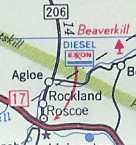 Today, I’m going to tell you about a town that did not exist (was not real), then came into being (became real), then disappeared (stopped existing) again.
Today, I’m going to tell you about a town that did not exist (was not real), then came into being (became real), then disappeared (stopped existing) again.
The story begins with a drafting (drawing plans and maps, usually for building) company hired to draw maps (see photo). In the 1930s, it was common for companies to hire a drafting company to make a map for use in their business, such as a chain of gas stations that wanted maps to sell or give to its customers. Unfortunately, it was also common for other companies to steal those maps, put their own company name on them, and use them without permission or payment. When accused of (saying someone broke a rule or committed a crime) stealing, those companies would simply say that their map is identical (exactly the same as the original) because it represents what exists (is there) in real life — all maps should look alike (the same) and have the same towns and roads, they would say.
A small company, called General Drafting Company, owned by Otto G. Lindberg, decided to strike back (defend themselves; counterattack). With the help of his assistant, Ernest Alpers, Lindberg created a map of New York State, and in an out-of-the-way place (place with nothing, no town or other structures) inserted (put in) the name of a made-up (created; not real) town called Agloe. (The word “Agloe” is an anagram (made by the mixing of letters) of the men’s initials: Otto G. Lindberg and Ernest Alpers.) They waited to see what would happen.
Many years later, a major and well-known map printing company called Rand McNally printed its own New York map. On that map was — you guessed it — the town of Agloe. Lindberg thought, “Finally, we have evidence of stealing!”
Lindberg took Rand McNally to court and something surprising happened. Rand McNally said they went to the place where Agloe is indicated (shown) on the map and there found a building with the name “Agloe” on it, showing that this town existed, that it was real. But how could this be, if the town was invented by Lindberg and Alpers?
It turns out that the owners of the building with the word “Agloe” on it had a store there in the 1950s. Before they started their business, they looked at a map distributed by the large gas station company that had bought a map from Lindberg and Alpers’s company, the General Drafting Company. Seeing the name Agloe where they planned to build their store, they decided to call it the Algoe General Store. So, technically (according to facts), you could make the case (use evidence to convince others) that the town existed, at least until the store went out of business (stopped operating). Rand McNally won the case.
As recently as the 1990s — and even more recently on Google Maps if the authors of this NPR article are correct — Algoe still appeared on many maps. And so, this is the story of a town that didn’t exist coming to life and then disappearing again. If you go there today, the town of Algoe does not exist — unless someone reads this blog post and decides to open another store there!
– Lucy
Image Credit: Fictional Agloe New York from Wikipedia
Interesting and funny story.
Poor Mr Lindberg! I felt sorry for him while reading this piece of news.
Thanks
It’s a funny story but a city isn’t a building ! thanks for your blog
Interesting!
Hi!
It’s weird to me!
Isn’t important that a town doesn’t have a mayor?
Narges from Iran
very interesting story and it look kind of weird.
Thank you
Funny story.
But in our country the town can’t appear if just one building is build there. I think that it must be regulated by some law document, some legal decisions must be formulated to make town real. And I just don’t understand how judge made this sentence.